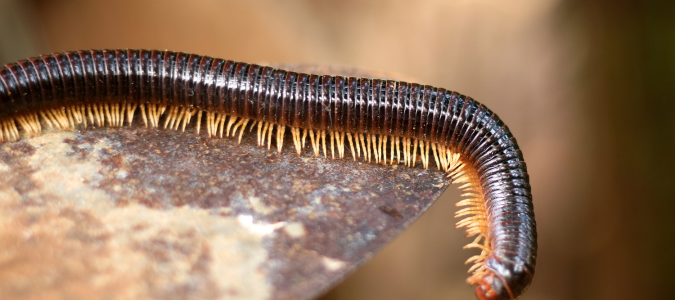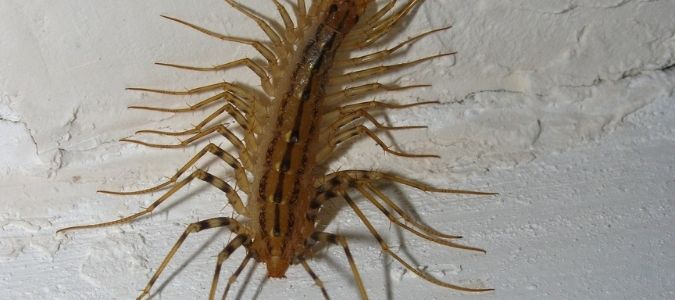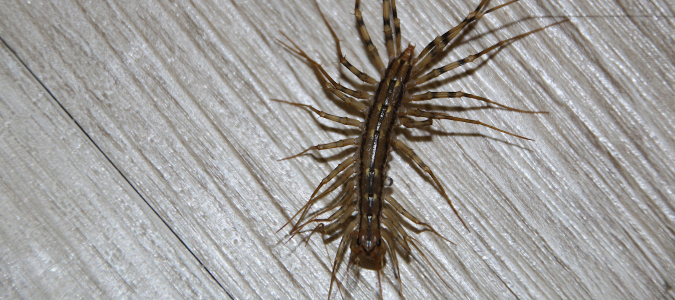Centipedes are fascinating insects known for having many legs. But how many legs do centipedes actually have? It may surprise you to know that the answer is not 100.
How Many Legs Does a Centipede Have?
Given their name, most people assume that centipedes have 100 legs. However, that is not the case. Centipedes can have anywhere from less than 15 legs to over 300 legs. Interestingly, they will always have an odd number of pairs of legs.
Centipedes have an odd number of leg pairs because they have one pair of legs per body segment, and they always have an odd number of body segments.
The number of legs that centipedes have also varies based on the species. For example, common house centipedes often have 15 pairs of legs, or 30 legs total. On the other hand, many tropical centipede species have around 150 pairs of legs or around 300 legs in total.
Since the number of legs centipedes have can vary, homeowners need to be able to identify them based on other factors. It’s hard to tell centipedes apart from other creepy crawling pests, but a little bit of knowledge can go a long way.
Centipedes Versus Millipedes
It’s easy to confuse centipedes with millipedes, pictured above. While these pests have several similarities, some key differences can help you tell them apart.
First, as mentioned above, centipedes have one pair of long and spread-out legs per body segment. Millipedes, on the other hand, have two pairs of legs per body segment, and they are shorter than centipede legs.
Because of these differences, centipedes are more agile and elongated than millipedes, while millipedes have rounder bodies. Millipedes also move slower than centipedes.
Centipedes have flat and segmented bodies, with a pair of long and sensitive antennae attached to their heads. Millipedes are known for their round bodies, and their segments are more uniform than centipede segments, which gives their bodies a smoother look.
There are also several differences between centipedes and millipedes in their behavior. Centipedes are known for darting away when they feel threatened, and their long legs help them scurry quickly.
Millipedes cannot move that quickly, so they roll into a ball when threatened. They rely on their hiding ability rather than run away to protect themselves from predators and threats.
Centipedes are carnivores that hunt for prey. Their front claws have venom, and they use these claws to paralyze insects and spiders. Millipedes prefer to feed on decaying organic matter, which makes them detritivores. Millipedes can be beneficial for your garden composting.
Centipedes Versus Arachnids
Both centipedes and arachnids, pictured above, are classified as arthropods because they have segmented bodies, jointed legs and hard exoskeletons. However, there are several differences between centipedes and arachnids, which include insects like spiders and scorpions.
For example, arachnids have only two body segments and eight legs and do not have antennae. Centipedes have several more body segments and a defined head. They also have more legs than arachnids, an antenna and elongated bodies.
Understanding the differences between centipedes and similar insects will help you understand what you’re dealing with in your home. However, if you see any pests in your home, do not hesitate to contact a pest control expert near you. The best way to kick creepy crawlers out of your home is with professional help. They can even help with other pests, like ground moles.
How Long Do House Centipedes Live?
House centipedes have surprisingly long lives compared to other indoor pests. Most live for a few years, but some live for up to seven years under the right conditions.
Because they live so long, centipedes can reproduce several times over their lifespan, so a small centipede infestation can quickly become a significant problem.
Centipede Appearance and Behavior
As mentioned above, centipedes are carnivores that hunt for prey. They prefer to feed on spiders, ants, termites, flies, silverfish, cockroaches and other small arachnids. Centipedes are agile hunters who use their venomous claws to trap and paralyze their prey.
House centipedes may reduce the number of other pesky insects in your home. However, this benefit does not outweigh the annoyances of a centipede infestation.
It’s important to understand what house centipedes look like so you can tell them apart from other common pests. House centipedes have long, segmented bodies measuring one to one and a half inches.
House centipedes usually have 15 pairs of legs that fan out from their body, which is why they sometimes resemble spiders. Their legs are also known for being striped with light and dark colors.
Centipedes have long antennae attached to their heads. They use their antenna to navigate their environment and search for prey. Finally, when it comes to color, centipedes are typically a yellowish-gray or brown color. They often have dark stripes along their body.
Are House Centipedes Harmful?
House centipedes are harmless to humans; however, they are an annoying pest to have in your home. They do not use their venom on humans, and it’s rare to be bitten by one. If they do bite you, the bite is typically not strong enough to break human skin and doesn’t cause any serious health risks.
The reason centipedes are annoying to have around your home is because of the way they quickly scurry across your floors and walls.
House centipedes enter homes in search of reliable food and water sources. They also seek shelter in damp and dark places, such as bathrooms, closets or basements.
Luckily, you can take steps to minimize a house centipede infestation. First, reduce moisture in damp areas using humidifiers in your basement and bathrooms. Next, seal up any entry points that house centipedes could use to enter your home. Lastly, remove piles of clutter, such as clothes and papers, where they could hide.
If the house centipede infestation gets out of control, contact your local pest control service. They will have the expert tools and experience needed to kick house centipedes out of your house and put effective prevention methods in place for the future. They can even help with other pests like red fire ants.
What Attracts House Centipedes? How to Deter Them From Your Home
Several things attract house centipedes into your home. For starters, they prefer damp and dark environments where they can hide and safely hunt for prey. Moisture also provides them with plenty of hydration. A home provides many environments that meet this criteria, such as basements, crawl spaces, bathrooms and closets.
Next, house centipedes feed on other insects that commonly live in homes, such as cockroaches, silverfish, crickets, spiders and more. If you already have a pest problem, house centipedes may be more interested in your home.
There are a few ways you can deter house centipedes. First, reduce moisture by repairing all leaks in your roof, foundation and plumbing. Next, ensure your bathrooms and laundry rooms have proper ventilation to avoid moisture buildup.
Eliminate house centipede food sources by keeping other pests out of your home. The best way to avoid pests is to keep your home free of crumbs and spills. If you already have a pest problem, contact a local expert to deal with it.
As mentioned above, sealing up entry points and keeping your home clutter-free can go a long way in deterring house centipedes. Finally, increasing the lighting in dark areas can help keep house centipedes at bay, as they typically seek out dark environments.
The best way to deal with a house centipede problem is to work with a pest control professional. An expert can provide personalized advice and efficiently deal with the pesky problem.
Kick Centipedes Out of Your Home With Professional Help
Centipedes are annoying pests known for scurrying through homes and hunting for prey. While these pests are harmless to humans, having a centipede infestation in your house is not fun.
There are easy steps you can take to deter centipedes, such as removing excess moisture from your home. However, working with a pest control professional is the most effective way to deal with a centipede problem.
ABC Can Treat Your Home for Creepy-Crawlies
Finding a centipede is enough to send a shiver down anyone’s spine. If you’re uncomfortable with the population of these pests around your property, contact ABC Home & Commercial Services. We will create a comprehensive pest control plan. They can also help you tell the difference between a house centipede or silverfish.





